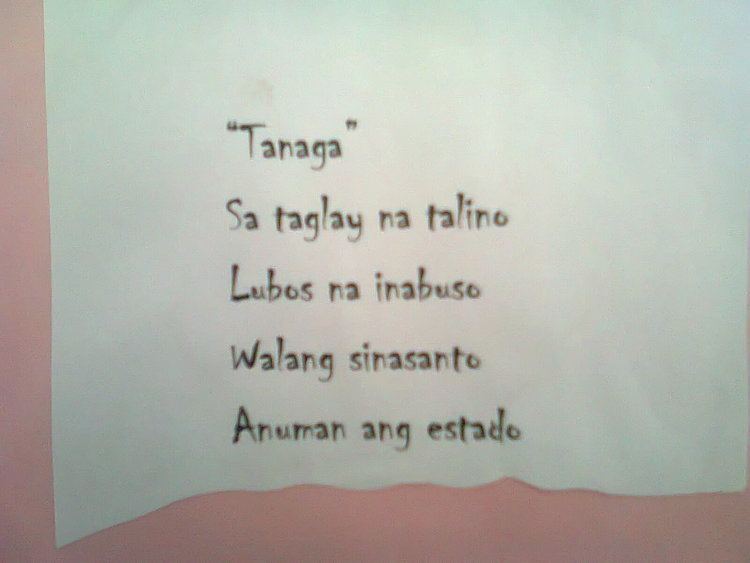Tanaga is a poem composed of four lines with each line having seven syllables written in aaaa or aabb abba or abab rhyming pattern. Traditional Japanese tanka poems consist of 31 syllables written in a single unbroken line.
The Japanese Period 1941 1945 Carpe Diem
Poets worked in pairs or small groups taking turns composing the alternating three-line and two-line stanzas.

Tanaga poetic form. They are poetic forms that should be able to stand on their own. I shall cower as the moss To you I shall. The Tanaga is a Filipino stanzaic form that was originally written in Tagolog which to my ear is one of the more musical of languages.
The poems are not titled. It consists of four lines each with seven syllables and the same rhyme at. Cordero is the founder of Savage Mind based in Naga Camarines Sur.
Tanka poems which originated in Japan are short poems intended to evoke vivid imagery and reflection for the reader. This poem appeared in our JulyAugust 2021 issue with three other tanagas by Aileen Cassinetto JoAnn Balingit and Luisa A. Other Stories Here is our interview with the editors and contributors of the anthology.
Tanaga is an Indigenous Filipino poetry form. AcoI momonting lomot sa iyoI popolopot Katitibay kang tulos Sakaling datnan ng agos. Akoy mumunting lumot sa iyoy pupulupot Oh be resilient you stake Should the waters be coming.
They are free verse so they do not have to rhyme but must follow specific syllable patterns. It comes in stanzas of four lines with seven syllables per line. However this varies depending on the rhyme schemes.
Photo courtesy of Savage Mind. Catitibay ca tolos sacaling datnang agos. Each is emotionally charged and asks a question that begs an anwer.
In English translations the tanka tends to take on a five-line form which brings us to this important note. These poems are made up of five units which after translation into English usually take the form of five lines. Here are some examples using the rhyme scheme AABB.
Front cover of Pitong Pantig Pintig at Pagitan with cover art by Gualberto Cea Manlagñit. As you study tanka poetry youll notice it bears a resemblance to sonnets. They follow a syllable pattern of 5-7-5-7-7 similar and yet longer than a haiku.
The tanaga form is part of an oral tradition going back to the early 16th century. When written in Japanese the form will follow a pattern of syllables 5-7-5-7-7In other words there are five syllables in the. Pentero wrote his introduction in the form of tanaga.
Most are handed down by oral history and contain proverbial forms moral lessons and snippets of a code of ethics. What is the Tanaga. It often rhymes even rhyming each line of a stanza on the same rhyme sound but it can have variable rhyme patterns.
Tanka Structure and Content. The majority are passed down by oral tradition and include proverbial forms moral precepts and bits of a code of ethics. My diona serves as an example.
Mabuti salam at The form dates back to the 16th century and has an oral tradition. They are poetic forms that should speak for themselves. History of the Tanka Form.
The Tanaga is a type of short Filipino poem consisting of four lines with seven syllables each with the same rhyme at the end of each line --- that is to say a. Tanka poems follow a five line form. Popular Trending About Us Asked by.
Linked together renga were often hundreds of lines long though the favored length was a 36-line form. Renga meaning linked poem began over seven hundred years ago in Japan to encourage the collaborative composition of poems. Midway through a tanka poem theres a change in perception.
A tanaga consists of four lines with seven syllables each with a rhyme at ending each line. A form of waka Japanese song or verse tanka translates as short song and is better known in its five-line 57577 syllable count form. The Tagalog tanaga which goes back to 1500 has been mistakenly described as the Philippine equivalent of the Japanese haiku.
Tanka The tanka is a thirty-one-syllable poem traditionally written in a single unbroken line. Poetry JulyAugust 2021 This Poem Appears In Read Issue Previous in Issue Next in Issue. A tanaga also known as luwa in Ilonggo is a pre-colonial Filipino short poetry that traditionally conveys philosophical concepts and viewpoints regarding the world events people and so on.
Tumatawag sa langit Sana ay wag ma galit Tadhanay makita Malimot pagdududa Ang pusong malimutin Sana ay baliktarin At hindi na aalis. It can also have more than one stanza. The Tanaga consists of four lines with seven syllables each with the same rhyme at the end of each line --- that is to say a 7-7-7-7 Syllabic verse with an AABB rhyme scheme.
A tanka poem is an important form in Japanese poetry that follows a syllable pattern of 5-7-5-7-7. Diona is a pre-Hispanic rhyming poem of three lines with seven syllables in each line expressing a complete thought. Like the Japanese haiku Tanagas traditionally do not have any titles.
Tanaga like the Japanese haiku are usually devoid of titles.

Tanaga Alchetron The Free Social Encyclopedia

Komentar